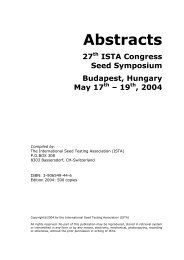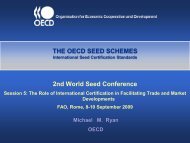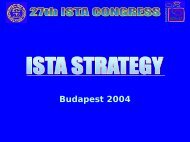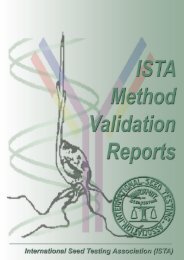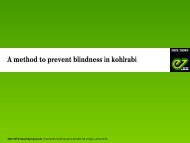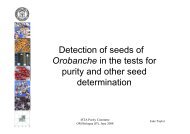Historical Paper - Volume 2 2008 - International Seed Testing ...
Historical Paper - Volume 2 2008 - International Seed Testing ...
Historical Paper - Volume 2 2008 - International Seed Testing ...
You also want an ePaper? Increase the reach of your titles
YUMPU automatically turns print PDFs into web optimized ePapers that Google loves.
H.A. JENSEN<br />
The stronger method required that the seeds, classified as pure seed, did not have any<br />
damage on vital parts of the seed. Undamaged seeds were, accordingly, considered to be<br />
able to germinate. As guidance, drawings of clover seeds with various degrees of damage<br />
were included in the Rules.<br />
The quicker method was based on the assumption that all pieces of seeds of the species<br />
tested, with a size of more than half the original size, should be classified as pure seed.<br />
The evaluation of whether the seeds were able to germinate was supposed to be determined<br />
in the germination test.<br />
The stronger method was tested by a comparison of results from identical clover<br />
samples, containing damaged seeds at eight seed testing laboratories. The results disclosed<br />
a difference of 6.6%. The lack of uniformity was mainly due to various interpretations of<br />
the descriptions of damages seeds (Saulescu and Szopos 1938).<br />
At the ISTA seed Congress in 1937 Franck (1938) gave an introduction to purity<br />
testing according to the stronger method and the quicker method, and Wright (1938)<br />
explained that the Canadians found the uniformity between tests improved and the time<br />
required for analysis reduced when using the quicker method.<br />
The discussion was interrupted by the 2 nd world war, but at the first ISTA Congress<br />
after the war Franck (1950) recommended once more the quicker method as the only<br />
allowed purity method in the ISTA Rules. By this time the quicker method was already in<br />
use both in USA, Canada and in the Scandinavian countries.<br />
ISTA’s two methods for purity testing became an increasing inconvenience for the<br />
seed trade, and the Russian delegation in the <strong>International</strong> Organization for Standardization<br />
(ISO) raised the question whether ISO should go into standardization of seed testing and<br />
that they should begin with purity. This question was submitted via the ISTA member<br />
countries standardization organizations to the ISTA laboratories and to the ISTA<br />
Secretariat. It was taken as a serious warning that decisions on formulation of the Rules<br />
could move to other organisations, and the ISTA Congress in 1950 finally decided that<br />
the stronger method should be deleted and the quicker method should be the only method<br />
for purity analysis in the ISTA Rules (Franck 1950).<br />
Purity tests of some of the tropical grass seed species are very time consuming.<br />
Accordingly, for Chloris gayana, the Irish method was compared with the ISTA purity<br />
methods for determination of pure live seed (Loch and Mulder 1987). The Irish method<br />
defines pure seed as any intact seed unit irrespective of whether a caryopsis is present or<br />
not. The ISTA purity method (PSD 42) requires that pure seed of Chloris gayana must<br />
contain a caryopsis. The comparison showed that the Irish method underestimated the<br />
content of Pure Live <strong>Seed</strong> by up to 10-20 percentage points.<br />
5.5 Evaluation of weed seeds<br />
A working group with the task to examine evaluation of weed seeds on the same basis<br />
as crop seeds was founded at the ISTA seed Congress in Munich 1965. Wold (1968) and<br />
Seaton (1975) reported that most of the 25 laboratories taking part in the investigation<br />
found that evaluation of weed seeds on the same basis as crop seeds had little effect on<br />
16



